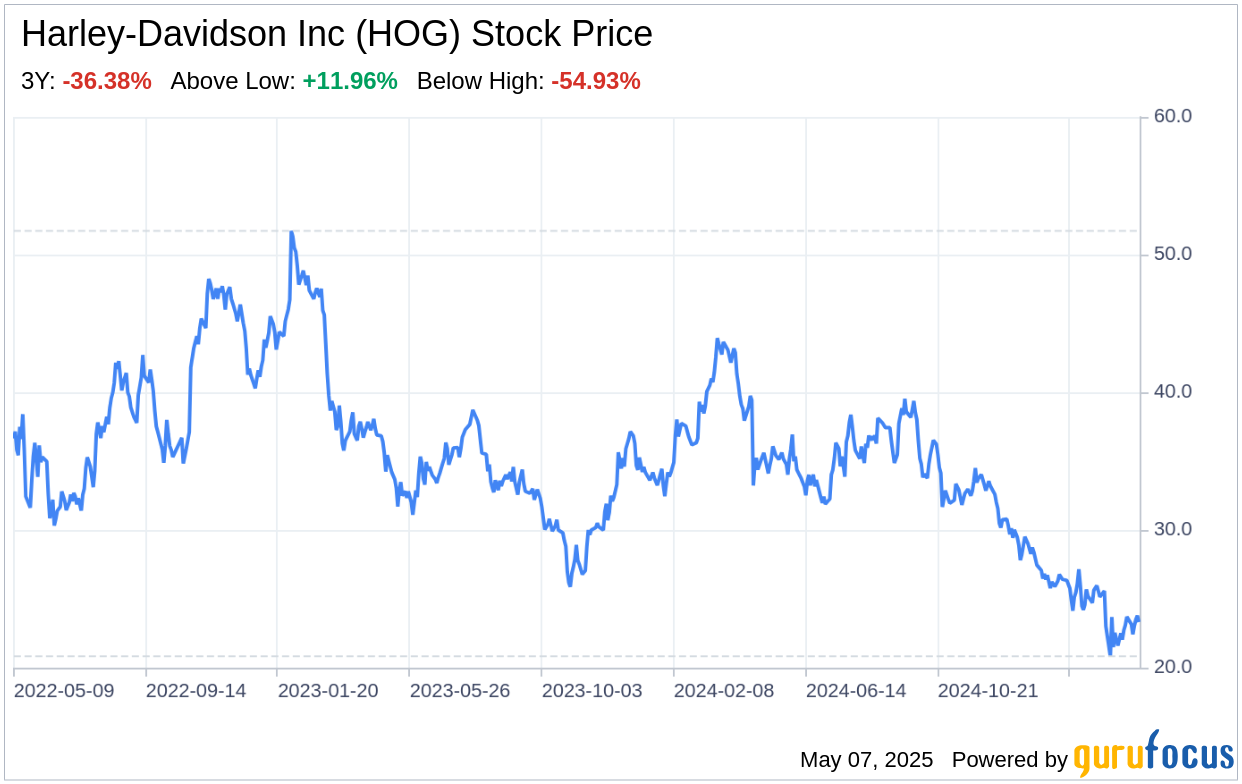On May 6, 2025, Harley-Davidson Inc (HOG, Financial) filed its 10-Q report, providing a snapshot of the company's financial health and operational performance for the first quarter of the year. The iconic motorcycle manufacturer reported a decrease in revenue from $1,729.6 million in Q1 2024 to $1,329.2 million in Q1 2025. Net income also saw a significant decline, from $234.9 million in the previous year to $133.1 million. Despite these challenges, the company's strong brand and market presence continue to be its bedrock, capturing around 37% of the heavyweight domestic market in 2024. This SWOT analysis will delve into the strengths, weaknesses, opportunities, and threats as revealed by the latest financial data and market trends.

Strengths
Brand Legacy and Customer Loyalty: Harley-Davidson Inc (HOG, Financial) boasts a storied brand that has cultivated a passionate and loyal customer base over its long history. This brand equity is a critical asset, as evidenced by the company's ability to maintain a significant share of the heavyweight motorcycle market. The brand's cultural impact and lifestyle appeal continue to attract enthusiasts, providing a competitive edge in the marketplace.
Financial Services Arm: The company's financial services segment, Harley-Davidson Financial Services (HDFS), remains a robust pillar of the business. With operating income from HDFS rising to $64.0 million in Q1 2025, this division provides a stable revenue stream and supports motorcycle sales through financing options, contributing to overall profitability.
Diversification into Electric Motorcycles: Harley-Davidson's expansion into the electric motorcycle market with the LiveWire brand represents a forward-thinking move to capture new growth segments. While still in its nascent stages, this strategic initiative positions the company to capitalize on the growing interest in sustainable transportation options.
Weaknesses
Declining Sales and Market Share: The latest financials indicate a concerning trend of declining sales, with a 21.3% drop in worldwide retail sales of new Harley-Davidson motorcycles in Q1 2025 compared to the same period in 2024. This decline reflects broader challenges in the heavyweight motorcycle market and suggests the need for strategic adjustments to reinvigorate sales.
Economic Sensitivity: Harley-Davidson's products are often considered discretionary purchases, making them highly sensitive to economic fluctuations. The current high-interest rate environment and economic uncertainty have adversely impacted consumer spending, as reflected in the company's reduced profitability.
Operational Inefficiencies: The company's cost structure, particularly in manufacturing and supply chain operations, may need further optimization. The decrease in operating income from the Harley-Davidson Motor Company (HDMC) segment by $122.2 million in Q1 2025 highlights the challenges of maintaining profitability amid lower shipments and unfavorable operating leverage.
Opportunities
Global Market Expansion: Harley-Davidson Inc (HOG, Financial) has the opportunity to expand its international presence, especially in emerging markets where the demand for motorcycles is growing. By leveraging its strong brand and developing tailored products for these markets, the company can tap into new customer segments and drive growth.
Product Innovation: The company's plans to introduce new models, including a small displacement motorcycle and an iconic classic cruiser, signal an ongoing commitment to product innovation. These initiatives, coupled with enhancements to existing platforms, can rejuvenate the product lineup and attract a broader customer base.
Strategic Partnerships and Investments: Harley-Davidson's evaluation of a potential investment into HDFS and the exploration of strategic partnerships present opportunities to enhance the value proposition of its financial services and secure long-term funding options, thereby strengthening its competitive position.
Threats
Competitive Pressures: The motorcycle industry is highly competitive, with numerous players vying for market share. Harley-Davidson Inc (HOG, Financial) faces intense competition from both established manufacturers and new entrants, particularly in the electric motorcycle segment, which could erode its market position.
Regulatory and Tariff Risks: Changes in tariffs and international trade policies pose significant risks to Harley-Davidson's operations. The potential impact of tariffs on the cost of raw materials and finished products could materially affect the company's pricing strategy and profitability.
Consumer Preference Shifts: The market for heavyweight motorcycles is subject to changing consumer preferences, including a shift towards more environmentally friendly transportation options. Harley-Davidson must continue to adapt its product offerings to align with these trends to maintain relevance and market share.
In conclusion, Harley-Davidson Inc (HOG, Financial) remains a formidable player in the motorcycle industry, bolstered by its iconic brand and dedicated customer base. However, the company must navigate a challenging economic landscape, adapt to shifting consumer preferences, and address operational inefficiencies to maintain its competitive edge. By capitalizing on opportunities for innovation and global expansion, Harley-Davidson can chart a course for sustained growth while mitigating the threats posed by competitive pressures and regulatory changes.
This article, generated by GuruFocus, is designed to provide general insights and is not tailored financial advice. Our commentary is rooted in historical data and analyst projections, utilizing an impartial methodology, and is not intended to serve as specific investment guidance. It does not formulate a recommendation to purchase or divest any stock and does not consider individual investment objectives or financial circumstances. Our objective is to deliver long-term, fundamental data-driven analysis. Be aware that our analysis might not incorporate the most recent, price-sensitive company announcements or qualitative information. GuruFocus holds no position in the stocks mentioned herein.
